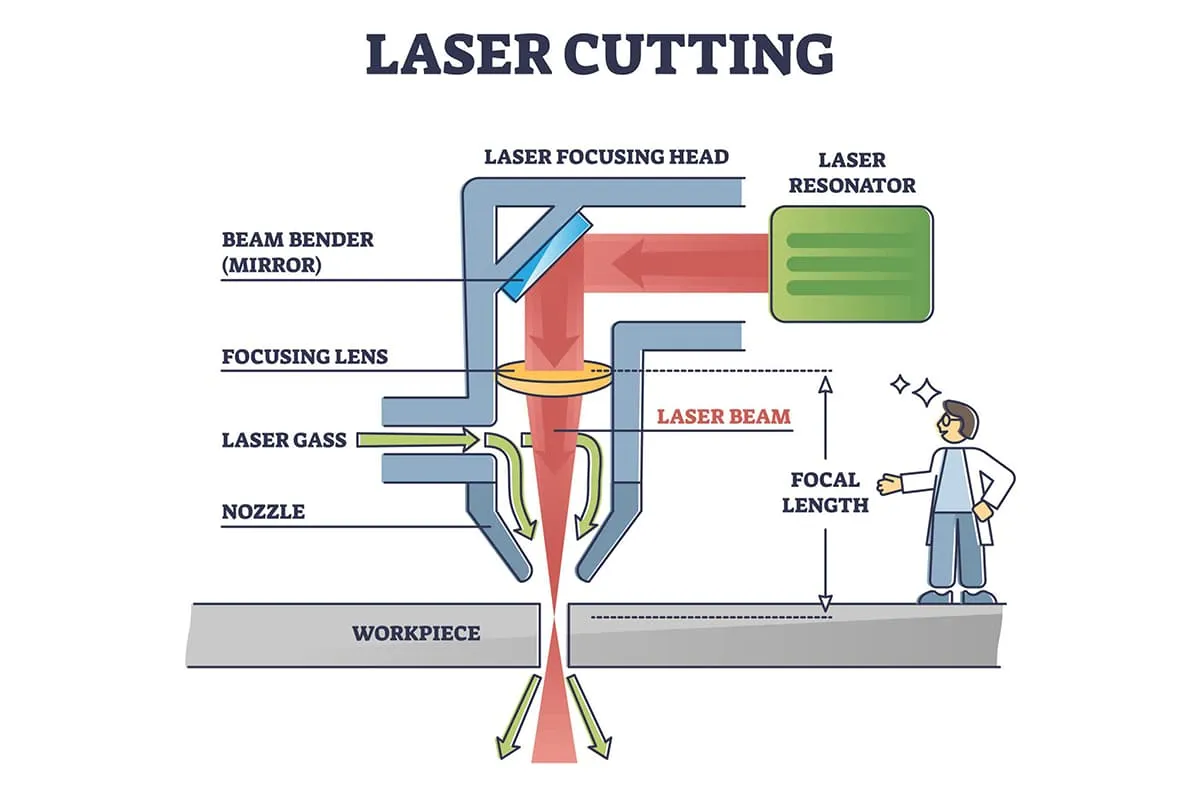Laser Cutting Principle
Laser cutting uses a focusing lens to concentrate the laser beam onto the surface of the workpiece, causing the material to melt. Simultaneously, a compressed gas, coaxial with the laser beam, blows away the molten material. The laser beam and the workpiece move relative to each other along a certain path, thereby creating a cut of a specific shape. The principle of laser cutting is illustrated in Figure 1.

1-Laser generator
2-Laser beam
3-Reflective mirror
4-Focusing lens
5-Assist gas
6-Nozzle
7-Workpiece
Classification of Laser Cutting
Laser cutting can be classified into four categories: laser fusion cutting, laser vaporization cutting, laser oxygen cutting, and laser scribing with controlled fracture.
Laser Fusion Cutting
Similar to laser deep penetration welding, laser fusion cutting utilizes laser heating to melt the metal material. Subsequently, a non-oxidizing gas (such as Ar, He, N, etc.) is sprayed through a nozzle coaxial with the laser beam to blow away the liquid metal, forming a cut.
Laser fusion cutting is primarily used for cutting materials that are not easily oxidized or for active metals, such as stainless steel, titanium and titanium alloys, aluminum and aluminum alloys.
Laser Vaporization Cutting
This method uses a high-power density laser beam to heat the surface of the workpiece, causing the temperature to rapidly rise to the material’s boiling point within an extremely short time. The material begins to vaporize rapidly, with a portion turning into vapor and the rest forming liquid and solid particles that are blown away from the bottom of the cut, creating the cut.
Laser vaporization cutting is commonly used for extremely thin metal materials and non-metal materials such as paper, fabric, wood, plastic, and rubber.
Laser Oxygen Cutting
The principle of laser oxygen cutting is similar to oxyacetylene cutting. The laser beam serves as a preheating heat source, while oxygen and other active gases are used as the cutting gases. The sprayed gas interacts with the cutting metal, leading to an oxidation reaction that releases a large amount of heat, heating the next layer of metal and causing it to continue oxidizing. Simultaneously, the molten oxides and melted materials are blown out of the reaction zone, forming the cut.
Laser oxygen cutting requires only half the energy of laser fusion cutting due to the substantial heat generated by the oxidation reaction during the cutting process. Moreover, the cutting speed is much faster than that of laser vaporization cutting and laser fusion cutting.
Laser oxygen cutting is suitable for materials that can be oxidized, such as iron-based alloys, titanium, and aluminum, among other non-ferrous metal materials.
Laser Scribing with Controlled Fracture
Laser scribing involves scanning the surface of brittle materials with a high-energy density laser beam to create a small groove or a series of small holes. Applying a certain pressure causes the brittle material to crack along the groove or hole. Controlled fracture utilizes the laser beam to heat the groove, creating local thermal stress in the brittle material, leading to its fracture along the groove.
Laser scribing with controlled fracture is suitable for cutting brittle materials such as stone, ceramics, glass, and cast iron.
Characteristics of Laser Cutting
Advantages:
High-quality cutting
The small laser beam spot and concentrated energy minimize workpiece thermal deformation, resulting in narrow kerfs (typically 0.10-0.20mm wide), smooth cutting surfaces, no burrs or slag, and the avoidance of edge collapse typically seen in shearing, eliminating the need for secondary processing.
Fast cutting speed and high precision
The small spot size and concentrated energy of the laser beam enable cutting speeds of up to 10m/min, significantly faster than wire cutting.
Non-damaging to the workpiece
Laser cutting is a non-contact cutting method, ensuring no contact with the workpiece surface, minimal noise, and minimal pollution.
Unaffected by material hardness and shape
Laser cutting can process materials such as stainless steel, aluminum alloys, and hard alloys, regardless of their hardness, and can produce any desired shape, including cutting thin and small-thickness pipes and other irregular profiles.
Capability to process non-metallic materials
This includes plastics, wood, PVC, leather, textiles, and organic glass.
Material and cost savings
Whole-sheet nesting and tailored cutting reduce labor and material costs.
Accelerated new product development
Once product designs are completed, laser processing can promptly produce physical products.
Disadvantages:
(1)Limited by laser power and equipment size, laser cutting is only suitable for cutting medium and small thickness plates and pipes, and cutting speed significantly decreases with increasing thickness.
(2)High equipment costs and substantial initial investment.
Applications of Laser Cutting
Laser cutting finds extensive application in various fields. In the automotive manufacturing sector, three-dimensional laser cutting machines are widely used in the production of car prototypes and small-batch production. Laser cutting of common thin plates and strips such as aluminum and stainless steel has achieved cutting speeds of up to 10m/min, significantly reducing production preparation cycles and enabling flexible workshop production.
In the aerospace industry, laser cutting is primarily used for cutting special aerospace materials such as titanium alloys, aluminum alloys, nickel alloys, chromium alloys, beryllium oxide, and composite materials. Aerospace components processed using laser cutting include engine flame tubes, thin-walled titanium alloy casings, aircraft frames, titanium skin, wing spars, tailplane panels, and helicopter main rotor blades.
Laser cutting technology also has a wide range of applications in the non-metallic materials field, enabling the cutting of high-hardness, brittle materials such as silicon nitride, ceramics, quartz, as well as flexible materials such as fabrics, paper, plastic sheets, and rubber. For instance, using lasers for garment nesting in clothing production can save 10% to 20% of fabric and increase productivity by more than threefold.

